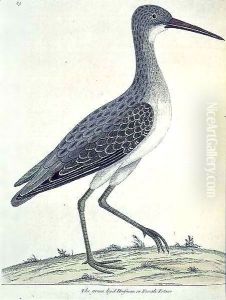Eleazar Albin Paintings
Eleazar Albin was a notable artist and naturalist, born around 1680, whose work significantly contributed to the early 18th-century understanding of ornithology and natural history. While the precise details of his birthplace remain somewhat obscure, it is suggested that he may have been of German descent. Albin made his way to England, where he would eventually make a lasting mark through his detailed and colorful illustrations of birds and other wildlife. His contributions during this period were instrumental in the development of natural history illustration, a field that was just beginning to gain scientific and academic recognition.
Albin's most famous work, 'A Natural History of Birds,' published in several volumes starting in 1731, showcased his meticulous approach to illustration. This work contained detailed engravings and descriptions of various bird species, many of which were based on specimens that he had access to in private collections and gardens in England. Albin's method involved observing live birds when possible, but he also worked from specimens, aiming to capture the vividness of their appearance and the intricacy of their forms. This attention to detail not only made his books highly valuable for scientific study but also turned them into works of art that appealed to a broader audience.
Beyond birds, Albin also published works on insects and other animals, contributing to a growing body of knowledge that would lay the foundations for modern zoology. His illustrations were among the first to accurately depict the natural world in a way that was both scientifically valuable and artistically appealing. Despite his significant contributions, Albin's life was not without its struggles. He often faced financial difficulties and had to solicit subscribers to fund his publications, a common practice at the time for independent scholars and naturalists.
Eleazar Albin's death in 1742 marked the end of a career that had significantly advanced the field of natural history illustration. His legacy, however, lived on through his detailed engravings and descriptions, which continued to be referenced and admired by naturalists and artists alike. Albin's work not only contributed to the scientific study of birds and other animals but also helped elevate the status of illustration as a valuable tool for understanding and appreciating the natural world.
